The 3 Legged Thing Lexie aims to please everybody. An L-bracket is a smart bit of kit for anybody who wants to quickly swap between landscape and portrait orientation shooting when using a tripod. 3 Legged Thing makes a wide range of dedicated L-brackets like the Zelda, to suit specific cameras. Engineered from a single piece of magnesium alloy, they’re very well made and deliver flawless performance. However, if you use more than one make or model of camera, their compatibility is naturally limited.

Following on from the 3 Legged Thing Ellie, the Lexie is a ‘universal’ L-bracket that you can adjust to fit almost any camera, saving the expense of multiple purchases. Catering to different tastes as well as different cameras, the Lexie is available in a choice of colors including, copper, metallic slate and ‘darkness’ (matte black).
3 Legged Thing Lexie: Specifications
Base length: 9.4cm / 3.7”
Working base range: 9.4 – 12.4cm / 3.7 – 4.88”
Vertical aspect: 8.4cm / 3.3”
Shoe compatibility: 38mm / 1.5” Arca-Swiss
Weight: 92g / 3.2oz
3 Legged Thing Lexie: Key features
Unless you’re using an especially big, hefty lens that has its own tripod mounting ring, swapping between landscape and portrait orientation shooting can be a pain. When you rotate the tripod head, the camera shifts position, so you’ll generally need to make further adjustments to maintain the same composition. Worse still, the camera will end up off-axis, with its weight no longer centered on the tripod. This results in a poor balance that can increase sag when making positional adjustments and, if you rotate the camera so that the shutter button is at the top for portrait orientation shooting, you also run the risk of it coming loose on its fixing screw.
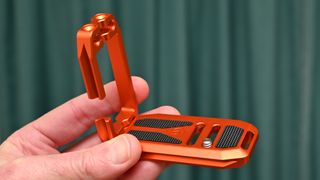
Typical of L-brackets, the Lexie fixes securely to the camera and enables easy switching between landscape and portrait orientation shooting, as it can be secured to the tripod using either the horizontal or vertical side of its L-shaped profile. To make it universal, it has an extendable base, so you can adjust its length to suit a wide range of cameras.
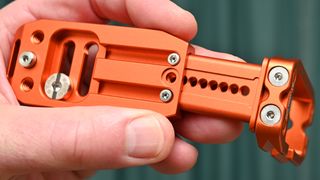
To extend compatibility even further, there are two different slots that you can use for the camera attachment screw, enabling a an optimum fit with perfect balance.
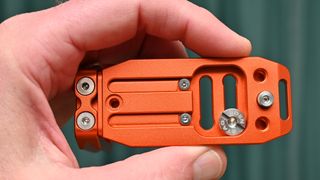
For securing the L-bracket to the tripod, the Ellie has an Arca-Swiss compatible profile on both of its horizontal and vertical mounting sections. The upright section has a large cutout, designed to maximize access to ports and sockets, frequently positioned on the left hand side of camera bodies. The horizontal section is also designed so that it doesn’t restrict the use of tilting or vari-angle touchscreens, as featured in most modern cameras.
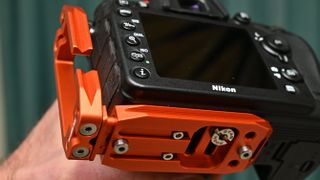
Catering to more than just cameras, the Lexie has two additional sockets in its base plate and a further two in its upright section, all with standard ¼-inch threads, so you can attach the likes of accessory arms, a microphone, monitor or an LED lamp.
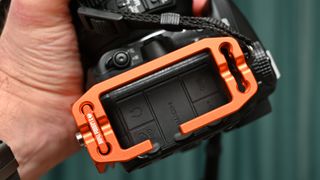
And if you happen to use a Peak Design Capture Clip V3, you’ll be pleased that the Ellie comes complete with a dedicated adapter for use with this.

3 Legged Thing Lexie: Build and handling
Build quality feels every bit up to 3 Legged Thing’s typically high standards. The Ellie is made from aerospace-grade magnesium alloy, so it’s lightweight yet tough. The sliding mechanism for tailoring it to different cameras is quick and easy to use, enhancing handling.

For added security and convenience, there’s a strap lug built into the base plate. The vertical section of the L-bracket can be detached altogether, by removing two hex screws, converting the Ellie into a quick-release base plate for using any camera with any Arca-Swiss compatible tripod head. Another handling bonus is that you can refit the upright section of the L-bracket in the opposite orientation. This enables you to rotate the tripod head into portrait orientation and use it as a rocker head, while maintaining a good center of balance.
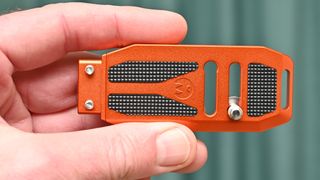
3 Legged Thing Lexie: Performance
A challenge in terms of performance is that the Ellie isn’t made from a single block of metal, unlike 3 Legged Thing’s dedicated L-brackets. However, we found that rigidity remained excellent even with the sliding mechanism at its longest extension. There’s no perceptible flexing in the joint between the base and upright sections.

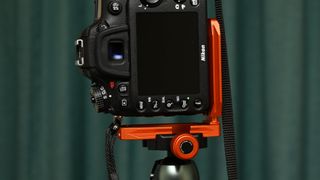
Adjustments are quick and simple to carry out, making the Ellie a superbly versatile bit of kit. We can’t guarantee that the cutout in the vertical section will enable access to the likes of HDMI, microphone and headphone sockets in every make and model of camera. However, any L-bracket is really designed with stills shooting in mind, rather than video, so even the worst case scenario shouldn’t prove a problem in practice.
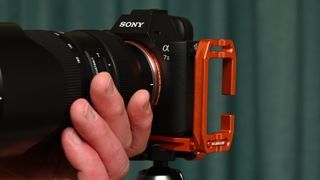
3 Legged Thing Lexie: Final Verdict
Like a dedicated L-bracket, the Lexie enables you to quickly swap between landscape and portrait orientation shooting when using a tripod, while retaining an excellent balance instead of having the camera hanging off one side of the tripod head. It also avoids a shift in camera position, so there’s less need to reframe the composition. The Lexie’s key advantage is its ‘universal’ design. We love that we can quickly and easily adjust it to suit pretty much any and every DLSR and mirrorless camera. It’s also surprisingly versatile for an L-bracket, with extra bonus features. One size really does fit all, and Lexie’s impeccable build quality and performance make it great value at the price.



